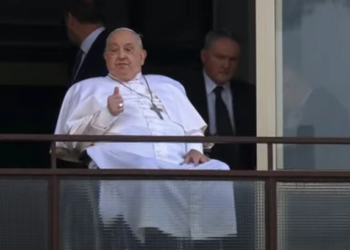At the top of our program, it said, “New York Philharmonic Presents.” Why is an orchestra presenting recitals? In any case, it was good to hear a violin-and-piano recital at David Geffen Hall on Tuesday night. Such a recital works well in this renovated hall. But let us not forget: there were plenty of good recitals—even great ones—in the old, “bad” hall.
Frankly, the musicians make a concert, not the hall.
Onstage two nights ago were Julia Fischer, the German violinist, and Jan Lisiecki, the Canadian pianist—Polish-Canadian pianist. The young man has a great mop of hair, like Paderewski, his legendary predecessor.
The program began with Mozart’s Sonata in B flat, K. 378. Mozart wrote many sonatas in B flat—for violin and piano and for piano alone. Normally, it is for him a key of geniality.
“Mozart is too easy for children, too hard for adults.” Who said that? Usually, it is attributed to Schnabel. And there is truth in it. Fischer and Lisiecki let their Mozart be simple, almost offhand. Their playing was clear and natural.
It was not immaculate. There was some disunity between the two players. And at the end of the first movement, Lisiecki might have had a clinker or two.
“Good,” I thought. “Life is not a studio recording,” all doctored up.
In the second movement, Mozart asks his players to sing. “Cantabile,” he instructs. Sing, our players did. And the closing Rondo was characterized by elegant merriment.
Beethoven wrote thirty-two piano sonatas, several of which have nicknames: “Pathétique,” “Moonlight,” etc. He wrote ten violin-and-piano sonatas, two of which have nicknames: “Spring” and “Kreutzer.” We heard the former on Tuesday night.
The opening movement had a nice walking tempo. It was a brisk walk, but still a walk. This movement is horizontal, liquid. But it also has some bite, breaking up, or complementing, all that smoothness. Fischer and Lisiecki were excellent in their accentuation.
And the violinist made such beautiful sounds. Quality of sound is not everything in music-making, but it counts.
The rest of the sonata? Fine, competent. I could pick—I would have had the piano lighter and spryer in the Scherzo—but this was commendable playing.
After intermission, there was another sonata—No. 2, in D minor, by Schumann. A thought occurred to me: “There are three great composers on this program. Is that legal?”
Fischer and Lisiecki began with their chords together. It may seem a little thing, but it’s not—it makes a difference. Moreover, plenty of musicians fail to do it.
Again, the violinist made beautiful sounds. She followed Schumann’s contours, rising and falling, swelling and subsiding. She has a Romantic heart. Plus, there is a touch of the Gypsy in her, as there must be in all violinists.
What a songwriter Schumann was—even when he was writing violin sonatas. His slow movement in the D minor is another of his songs. Once more, our performers sang admirably.
The audience, on its feet, wanted an encore, and it got one: Brahms. (A fourth great composer!) This was his Scherzo in C minor. Lisiecki, in particular, gave it a marvelous galloping energy.
The audience, energized, wanted another encore. It got one: Tchaikovsky. (Five!) This was his Melody in E flat, played dearly.
So, it was a soft send-off. The audience would have kept them going, but Fischer and Lisiecki bade farewell. They are an appealing, warm duo.















